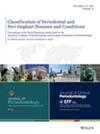Melatonin inhibits orthodontically induced root resorption through YAP/P65/IL-6 signaling pathway.
IF 3.8
2区 医学
Q1 DENTISTRY, ORAL SURGERY & MEDICINE
引用次数: 0
Abstract
BACKGROUND To explore the effects and mechanisms of melatonin on orthodontically induced root resorption (OIIRR) by focusing its role on IL-6 secretion in human periodontal ligament cells (hPDLCs). METHODS Cytokine array was used to identify the key inflammatory cytokine secreted by hPDLCs under excessive compressive force. Western blot analysis and immunohistochemistry staining (IHC) were conducted to examine the key proteins in the YAP/P65/IL-6 signaling pathway both in in vitro and in vivo experiments. Verteporfin, a YAP inhibitor, was used to confirm the involvement of p-YAP and its downstream signaling factor p-P65. Root resorption volume was assessed using micro-computed tomography (micro-CT). RESULTS Cytokine array revealed that excessive compressive force significantly elevated interleukin-6 (IL-6) levels in hPDLCs. IHC indicated that both IL-6 and melatonin receptor 1 (MT1) were highly expressed in hPDLCs on the compressive side in the mouse OIIRR model. in vitro experiments demonstrated that the levels of p-YAP and p-P65 significantly increased when compressive force was applied to hPDLCs, and melatonin reversed this effect. Furthermore, Verteporfin produced effects similar to melatonin on IL-6 expression and the YAP/P65 signaling pathway. Micro-CT analysis showed noticeable root resorption in the mouse OIIRR model, which was significantly reduced following intraperitoneal injection of melatonin. IHC staining further confirmed that the YAP/P65/IL-6 signaling pathway was inhibited on the compressive side of the mouse OIIRR model after melatonin injection. CONCLUSIONS Melatonin was able to inhibit root resorption in the mouse OIIRR model and reduced IL-6 secretion in hPDLCs under compressive force by suppressing the YAP/P65 signaling pathway. PLAIN LANGUAGE SUMMARY This study explored how melatonin, a natural hormone, protects against root resorption during orthodontic treatment. Specifically, we focused on how excessive compressive force induces IL-6 production and root resorption in both in vitro and in vivo experiments. in vitro, we found that applying compressive force to hPDLCs increased the release of IL-6, a molecule that promotes inflammation and bone resorption. Melatonin, however, reduced IL-6 levels by blocking the YAP/P65 signaling pathway. In vivo, we developed a mouse model of orthodontically induced root resorption, in which melatonin was injected intraperitoneally. Results showed that melatonin reduced root resorption and decreased IL-6 secretion in the periodontal tissues. Additionally, proteins of the YAP/P65 signaling pathway and the RANKL/OPG system were involved in vivo. Our findings suggest that melatonin could be a promising preventive approach to protect against root resorption during orthodontic treatment.褪黑素通过YAP/P65/IL-6信号通路抑制正畸诱导的牙根吸收。
背景通过研究褪黑素对人牙周韧带细胞(hPDLCs) IL-6分泌的影响,探讨褪黑素对正畸诱导的牙根吸收(OIIRR)的影响及其机制。方法采用细胞因子阵列法,鉴定高压下hpdlc分泌的关键炎性细胞因子。体外和体内实验采用Western blot分析和免疫组化染色(IHC)检测YAP/P65/IL-6信号通路的关键蛋白。使用一种YAP抑制剂Verteporfin来证实p-YAP及其下游信号因子p-P65的参与。使用微型计算机断层扫描(micro-CT)评估牙根吸收体积。结果细胞因子分析显示,过大的压缩力可显著提高hpdlc中白细胞介素-6 (IL-6)水平。IHC显示IL-6和褪黑激素受体1 (MT1)在小鼠iirr模型中压缩侧hpdlc中均高表达。体外实验表明,当施加压力时,hpdlc的p-YAP和p-P65水平显著增加,褪黑激素逆转了这一作用。此外,维替波芬对IL-6表达和YAP/P65信号通路的影响与褪黑素相似。显微ct分析显示小鼠OIIRR模型有明显的根吸收,腹腔注射褪黑激素后明显减少。免疫组化染色进一步证实,褪黑素注射后小鼠OIIRR模型受压侧YAP/P65/IL-6信号通路受到抑制。结论:在小鼠OIIRR模型中,褪黑素能够抑制根吸收,并通过抑制YAP/P65信号通路,降低受压hPDLCs中IL-6的分泌。摘要本研究探讨了褪黑素(一种天然激素)在正畸治疗过程中如何防止牙根吸收。具体来说,我们在体外和体内实验中关注了过大的压缩力如何诱导IL-6的产生和根的吸收。在体外,我们发现对hpdlc施加压缩力可以增加IL-6的释放,IL-6是一种促进炎症和骨吸收的分子。然而,褪黑素通过阻断YAP/P65信号通路降低IL-6水平。在体内,我们建立了一个正畸诱导牙根吸收的小鼠模型,在模型中,我们通过腹腔注射褪黑激素。结果显示,褪黑素可减少牙根吸收,降低牙周组织中IL-6的分泌。此外,体内YAP/P65信号通路和RANKL/OPG系统的蛋白也参与其中。我们的研究结果表明,在正畸治疗期间,褪黑素可能是一种有希望的预防牙根吸收的方法。
本文章由计算机程序翻译,如有差异,请以英文原文为准。
求助全文
约1分钟内获得全文
求助全文
来源期刊

Journal of periodontology
医学-牙科与口腔外科
CiteScore
9.10
自引率
7.00%
发文量
290
审稿时长
3-8 weeks
期刊介绍:
The Journal of Periodontology publishes articles relevant to the science and practice of periodontics and related areas.
 求助内容:
求助内容: 应助结果提醒方式:
应助结果提醒方式:


